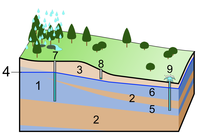
Photo from wikipedia
In the present study, a 42-year record of rainfall and temperature from Airport and a 43-year rainfall record from Kizimbani meteorological station were analyzed to understand how these climatic variables… Click to show full abstract
In the present study, a 42-year record of rainfall and temperature from Airport and a 43-year rainfall record from Kizimbani meteorological station were analyzed to understand how these climatic variables are affecting groundwater supply on the Island of Zanzibar, Tanzania. Water table fluctuation (WTF) and rainfall data were examined for estimating groundwater recharge. The abstraction volume and recharge rate were used to estimate the water balance. Also, the different physicochemical parameters, such as chlorinity, nitrate, electrical conductivity (EC) and total dissolved solids (TDS) were examined to assess the impact of groundwater pumpage on water quality on the island of Zanzibar. Through the use of WTF method, the present study estimated the recharge rates, local sustainable yield (SY) and integrated water balance (IWB). Rainfall records showed that Zanzibar Island receives a total mean annual rainfall of 1673 mm out of which 7% (equivalent to 1.79 × 106 m3/y) recharges the groundwater. Temperature variations indicated an incremental trend accompanied by low rainfall. The average estimated SY was 0.72%, while the IWB showed a deficit of 39%. Furthermore, the total groundwater abstraction rate in the studied area was 2.49 × 106 m3/y, which was higher than the rate of recharge. This means that the groundwater resources are currently over-exploited and, if immediate action is not taken, the groundwater aquifers may be subjected to pollution, collapse and seawater intrusion. The effects of over-pumping were manifested by high levels of EC, chloride, TDS, total hardness and nitrate that showed an increasing trend with time.
Journal Title: Environmental Earth Sciences
Year Published: 2020
Link to full text (if available)
Share on Social Media: Sign Up to like & get
recommendations!